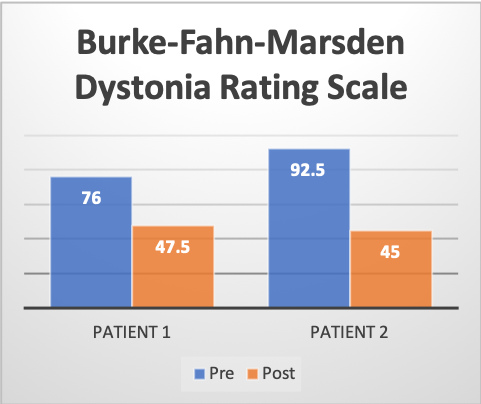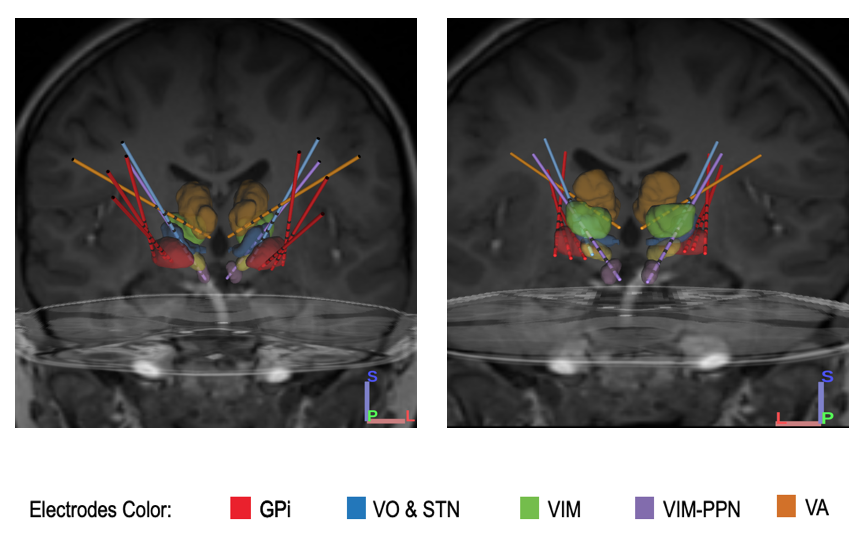Objective: Investigate the efficacy of deep brain stimulation (DBS) in the pedunculopontine nucleus (PPN) for the treatment of dystonia in pediatric patients.
Background: Deep brain stimulation is a well documented therapy for dystonia utilized in many adult and pediatric disorders. PPN has been investigated as a DBS target primarily in adult patients with dystonia from Parkinson’s disease, showing improvement in postural instability and gait dysfunction. Due to the difficulty in targeting PPN using standard techniques, it is not commonly chosen as a target for adult or pediatric pathology. There is no current literature describing the targeting of PPN in DBS for childhood-onset dystonia.
Method: Two pediatric patients with childhood-onset dystonia and DBS implantation at our institution were identified. Patient 1 has Mitochondrial Enoyl CoA Reductase Protein-Associated Neurodegeneration (MEPAN) syndrome. Patient 2 has Glutaric Aciduria Type 1 (GA1). Temporary depth electrodes had been placed in six locations bilaterally (for a total of 12 electrodes) and tested during a 5- to 7-day hospitalization, which identified the optimal targets for permanent implants. Pre- and post-operative videos taken as part of routine clinical assessments were evaluated and scored on the Burke-Fahn Marsden Dystonia Rating Scale (BFMDRS). Both patients had permanent electrodes placed bilaterally in PPN and globus pallidus internus (Gpi). Patient #1 was scored at 4 months post-op. Patient #2 was scored at 6 weeks post-operatively, at time of submission. Response to PPN in permanent electrodes was confirmed by decline in function after temporarily turning off PPN stimulation for clinical purposes, with immediate worsening noted.
Results: Both patients experienced no perioperative complications with DBS placement. At time of scoring, patient #1 demonstrated a 37.5% improvement in the BFMDRS scale (76.0 to 47.5), and patient #2 had 51.4% improvement (92.5 to 45.0).
Conclusion: DBS in PPN was safely and successfully used in 2 pediatric patients with childhood-onset dystonia. These patients showed clinically significant improvements in BFMDRS scoring post operatively. This represents the first reported DBS targeting of PPN in pediatric patients, and suggests PPN is a safe and effective target in DBS for childhood-onset dystonia.
To cite this abstract in AMA style:
J. Davies, J. Kurtz, J. Maclean, T. Sanger, M. Liker, J. Olaya. Novel utilization of deep brain stimulation in the pedunculopontine nucleus for treatment of childhood-onset dystonia [abstract]. Mov Disord. 2023; 38 (suppl 1). https://www.mdsabstracts.org/abstract/novel-utilization-of-deep-brain-stimulation-in-the-pedunculopontine-nucleus-for-treatment-of-childhood-onset-dystonia/. Accessed December 6, 2025.« Back to 2023 International Congress
MDS Abstracts - https://www.mdsabstracts.org/abstract/novel-utilization-of-deep-brain-stimulation-in-the-pedunculopontine-nucleus-for-treatment-of-childhood-onset-dystonia/


